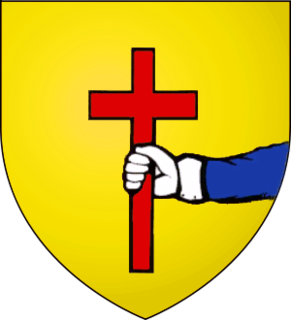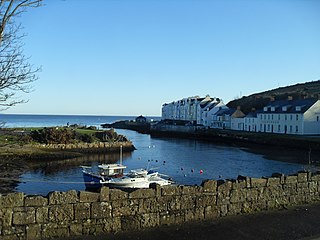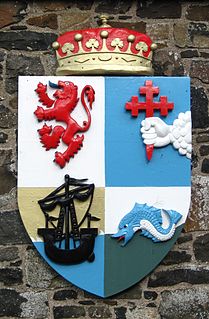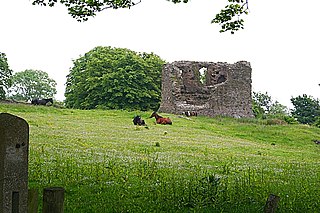| |||||
| Centuries: | |||||
|---|---|---|---|---|---|
| Decades: | |||||
| See also: | Other events of 1567 List of years in Ireland | ||||
Events from the year 1567 in Ireland.
| |||||
| Centuries: | |||||
|---|---|---|---|---|---|
| Decades: | |||||
| See also: | Other events of 1567 List of years in Ireland | ||||
Events from the year 1567 in Ireland.
Sorley Boy MacDonnell, also spelt as MacDonald, Scoto-Irish chief, was the son of Alexander MacDonnell, lord of Islay and Kintyre (Cantire), and Catherine, daughter of the Lord of Ardnamurchan, both in Scotland. MacDonnell is best known for establishing the MacDonnell clan in Antrim, Ireland, and resisting the campaign of Shane O'Neill and the English crown to expel the clan from Ireland. Sorley Boy's connection to other Irish Catholic lords was complicated, but also culturally and familiarly strong: for example, he married Mary O'Neill the daughter of Conn O'Neill. He is also known in English as Somerled and Somerled of the yellow hair.

Hugh O'Neill, was an Irish Gaelic lord, Earl of Tyrone and was later created The Ó Néill Mór, Chief of the Name. O'Neill's career was played out against the background of the Tudor conquest of Ireland, and he is best known for leading the resistance during the Nine Years' War, the strongest threat to Tudor authority in Ireland since the revolt of Silken Thomas.

Sir Henry Sidney, Lord Deputy of Ireland, was the eldest son of Sir William Sidney of Penshurst, a prominent politician and courtier during the reigns of Henry VIII and Edward VI, from both of whom he received extensive grants of land, including the manor of Penshurst in Kent, which became the principal residence of the family.

Shane O'Neill, was an Irish chieftain of the O'Neill dynasty of Ulster in the mid-16th century. Shane O'Neill's career was marked by his ambition to be the O'Neill—sovereign of the dominant O'Neill family of Tír Eoghain—and thus overlord of the entire province. This brought him into conflict with competing branches of the O'Neill family and with the English government in Ireland, who recognised a rival claim. Shane's support was considered worth gaining by the English even during the lifetime of his father Conn O'Neill, 1st Earl of Tyrone. But rejecting overtures from Thomas Radclyffe, 3rd Earl of Sussex, the lord deputy from 1556, Shane refused to help the English against the Scottish settlers on the coast of Antrim, allying himself for a short time instead with the MacDonnells, the most powerful of these settlers, Shane viewed the Scottish settlers as invaders, but decided to stay his hand against them with hopes of using them to strengthen his position with the English; however, tensions quickly boiled over and he declared war on the Scottish MacDonnell's defeating them at the Battle of Glentaisie despite the MacDonnells calling for reinforcements from Scotland. The Scottish MacDonnells would later assassinate Shane O'Neill and collect the bounty on his head.
Manus O'Donnell was an Irish lord and son of Sir Hugh Dubh O'Donnell. He was an important member of the O'Donnell dynasty based in County Donegal in Ulster.

Sir Phelim Roe O'Neill of Kinard, was an Irish nobleman who led the Irish Rebellion of 1641 in Ulster, which began on 23 October 1641. He joined the Irish Catholic Confederation during the Wars of the Three Kingdoms, in which he fought under his kinsman and second cousin, Owen Roe O'Neill in the Confederate Ulster Army. In 1653 Phelim O’Neill had sought refuge on an old crannog in Roughan Lough while staying at Roughan Castle but was captured after his hideout was betrayed.
Hugh Roe O'Donnell, also known as Red Hugh O'Donnell, was a sixteenth-century Irish nobleman. He became Chief of the Name of Clan O'Donnell and Lord of Tyrconnell in 1593 after a succession dispute within the O'Donnell dynasty, and after escaping a five-year imprisonment in Dublin Castle by the English. Along with his father-in-law Hugh O'Neill of Tyrone, he led an alliance of Irish clans in the Nine Years' War against the English government in Ireland. Hugh Roe led an Irish army to victory in the Battle of Curlew Pass. After defeat in the Siege of Kinsale, he travelled to Spain to seek support from King Philip III. Unsuccessful, he died in Spain and was succeeded by his younger brother Rory O'Donnell. He is sometimes also known as Aodh Ruadh II or Red Hugh II, especially in his native County Donegal.

The O'Donnell dynasty were the dominant Irish clan of the kingdom of Tyrconnell, Ulster, in medieval and early-modern Ireland.
The Battle of Farsetmore was fought near Letterkenny in County Donegal, north-western Ireland, on 8 May 1567, between the O'Neill and O'Donnell Túath. Shane O'Neill, chief of the O'Neills of Tír Eoghain, was defeated by Aodh mac Maghnusa Ó Domhnaill and the O'Donnells freed themselves from O'Neill aspirations of ruling Ulster as its King.

Cushendun is a small coastal village in County Antrim, Northern Ireland. It sits off the A2 coast road between Cushendall and Ballycastle. It has a sheltered harbour and lies at the mouth of the River Dun and Glendun, one of the nine Glens of Antrim. The Mull of Kintyre in Scotland is only about 15 miles away across the North Channel and can be seen easily on clear days. In the 2001 Census it had a population of 138 people. It is part of Causeway Coast and Glens district.
During the Tudor conquest of Ireland (c.1540–1603), "surrender and regrant" was the legal mechanism by which Irish clans were to be converted from a power structure rooted in clan and kin loyalties, to a late-feudal system under the English legal system. The policy was an attempt to involve the clan chiefs within the English polity, and to guarantee their property under English common law, as distinct from the traditional Irish Brehon law system. This strategy essentially sought to assimilate the Gaelic leadership into the new Tudor Kingdom of Ireland and Anglican Church, contrary to more radical opinions which sought outright extermination.
The Battle of Glentaisie, was a battle between the native Ulster Irish and Scottish settlers the MacDonnell's fought in the north of Ulster on 2 May 1565. The result was a victory for Shane O'Neill over the Clan MacDonald of Dunnyveg. The conflict was a part of the political and military struggle, involving the English and occasionally the Scots, for control of northern Ireland. Although the MacDonalds were a Scottish family, based principally on the island of Islay in the Hebrides, they had long been associated with the Gaelic polity rather than the Kingdom of Scotland.

The MacDonnells of Antrim, also known as the MacDonnells of the Glens, are a branch in Ireland of the primarily Scottish-based Clan Donald. Initially part of Clan MacDonald of Dunnyveg, the MacDonnells of Antrim became their own branch in 1558 when Somhairle Buidhe MacDonnell obtained the lordship of the territory in Ireland from James MacDonald, 6th chief of the Clan MacDonald of Dunnyveg. The MacDonnells of Antrim were a sept of the powerful Clan Donald of the royal Clann Somhairle,, that the English crown had attempted to cultivate since the early 14th century in its efforts to influence the course of politics in Scotland. The MacDonnells established a growing presence in Ireland throughout the 15th and 16th centuries, and played a crucial role in the politics of 17th century Ireland. The MacDonnell's achieved much success in Ireland largely to cultural and familial connections to the Gaelic nobility of Ireland. Today the surname is predominantly spelled McDonnell in Ireland and abroad, although many McConnells are also of the same family, as are the McDaniels. Many of the present day McDonnells have a common descent from Sorley Boy MacDonnell.

The O'Neill dynasty is a lineage of Irish Gaelic origin, that held prominent positions and titles in Ireland and elsewhere. As Kings of Cenél nEógain, they are historically the most prominent family of the Northern Uí Néill, along with the O'Donnell dynasty. The O'Neills hold that their ancestors were kings of Ailech during the Early Middle Ages, as descendants of Niall of the Nine Hostages.
Events from the year 1585 in Ireland.

MacShane is a patronymic surname originating in Ireland. The surname evolved from the given name Shane, a derivative of John, of Hebrew origin. Early records spelled the name Mac Seáin or Mac Seagháin. Historically, the MacShanes from Ulster are a branch of the O'Neills, while in County Kerry, the surname was adopted by the Fitzmaurices. MacShane is uncommon as a given name.
Events from the year 1566 in Ireland.
Flaithrí Ó Maolchonaire, was an Irish Franciscan and theologian, founder of the College of St Anthony of Padua, Leuven, and Archbishop of Tuam.

Tibbot na Long Bourke, anglicised as Theobald Bourke, was an Irish peer and parliamentarian. A prominent member of the MacWilliam Burkes of County Mayo, Tibbot was a Member of the Irish House of Commons and was later created the first Viscount Mayo. His successful life followed, and usefully illustrates, the difficult transition for Irish aristocrats from the traditional Gaelic world during the Tudor conquest of Ireland.

Carra Castle or Castle Carra is a ruined castle, just north of Cushendun, County Antrim, Northern Ireland. It dates to around the early 14th century. The castle lies in a field near the coast and the harbour of Cushendun. The site had once been used during medieval times as a children's cemetery.